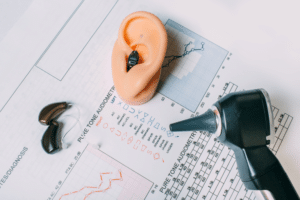
Hearing loss can have a significant impact on one’s quality of life, affecting communication, social interactions, and overall well-being. Fortunately, advancements in technology have led to the development of hearing aids, which can help individuals with hearing loss regain their ability to hear and participate fully in daily activities. In this guide, we’ll explore how hearing aids work, the key components that make them function, and the various types available to meet different needs.
Hearing Aids Amplify Sound Waves: At their core, hearing aids work by amplifying sound waves, making them louder and clearer for the wearer. When sound enters the ear canal, it causes the eardrum to vibrate. These vibrations are then transmitted through the tiny bones in the middle ear to the cochlea, a fluid-filled organ responsible for converting sound vibrations into electrical signals that the brain can interpret.
Basic Components of a Hearing Aid:
Microphone: The microphone is the part of the hearing aid that picks up sound from the environment. It converts sound waves into electrical signals.
Amplifier: The amplifier receives the electrical signals from the microphone and amplifies them to a level that is appropriate for the individual’s hearing loss.
Receiver: The receiver delivers the amplified sound to the ear canal, where it is then transmitted to the cochlea.
Battery: The battery powers the hearing aid and allows it to function properly.
Modern hearing aids often incorporate digital signal processing (DSP) technology, which allows for advanced signal processing to enhance sound quality and clarity. DSP enables hearing aids to differentiate between speech and background noise, suppress feedback, and adjust amplification levels based on the wearer’s listening environment. This sophisticated technology helps individuals hear more clearly in various situations, from quiet conversations to noisy environments like restaurants or crowded events.
Different Types of Hearing Aids and Their Functionalities:
Behind-the-Ear (BTE): BTE hearing aids are worn behind the ear and are suitable for individuals with mild to profound hearing loss. They are known for their durability and versatility.
In-the-Ear (ITE): ITE hearing aids are custom-made to fit inside the outer ear. They are less visible than BTE models and are suitable for mild to severe hearing loss.
In-the-Canal (ITC): ITC hearing aids are smaller than ITE models and fit partially in the ear canal. They are suitable for mild to moderate hearing loss and offer a more discreet option.
Completely-in-Canal (CIC): CIC hearing aids are the smallest and most discreet type, fitting completely inside the ear canal. They are suitable for mild to moderate hearing loss.
Hearing aids play a crucial role in improving the quality of life for individuals with hearing loss. By amplifying sound waves, utilizing advanced digital signal processing, and incorporating various types and functionalities, hearing aids can help individuals hear more clearly and participate fully in conversations and activities. If you or a loved one are experiencing hearing loss, consult with a qualified audiologist to explore the best hearing aid options for your needs and lifestyle.